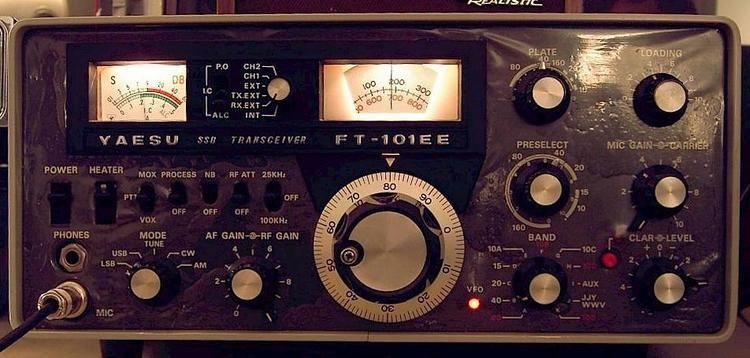 | ||
Yaesu FT-101 is a model line of modular amateur radio transceivers, built by the Yaesu Corporation in Japan during the 1970s and 1980s. FT-101 is a set that combines a solid state transmitter, receiver and a tube final amplifier. Its solid state features offer high-performance, low-current characteristics and its tube amplifier provides an almost mismatch-resistant transmitter and tuner stage. FT-101’s were made with plug-in circuit boards that could be sent to the dealer or factory for replacement or repair. Until then, modular design was unprecedented in the amateur community. This also explains the fact why so many FT-101's are still in use today. The rig was sold worldwide as Yaesu FT-101 and in Europe as Yaesu FT-101 and as Sommerkamp FT-277. Because of its reliability it earned its nickname "the workhorse".
Contents
Technical description
The original FT101 Series (1971-1977) had dual conversion, with 5 MHz Receiver first IF, a very stable and linear 9 MHz VFO and 3.2 MHz 2nd IF. They had a 12BY7A tube driver feeding two 6JS6C television sweep tubes providing a nominal output power of 130 watts peak envelope power in single sideband, 90 watts continuous wave and 40 watts amplitude modulation. The 6JS6C tubes are matched to the antenna through a conventional pi network. This transforms 3000 ohm output impedance of the tubes to a low impedance, typically 25 to 200 Ohms. These tubes were generally found to be more rugged and longer lasting than 6146 tubes used in other rigs.
These rigs were extremely reliable, and various improvements were made over the model range, especially to the receiver, from Mk1, Mk2, B and E models (very few F models were ever produced). This was also one of the first all-in-one box rigs, as it had a built-in mains and 12V DC inverter power supply and even a loudspeaker, which made it ideal to use portable (it even had a carrying handle on the side). They also included two switched crystal-controlled positions for Maritime Mobile use (a legal requirement in those days).
All models after the Mk1 came with a PA fan, and the E models had a built-in RF Speech Clipper.
Thousands of these transceivers are still going strong today, as even if any parts do fail, they are readily replaceable with standard components. Sherwood Engineering lists this rig as having one of the most sensitive and quietest receivers of any rig.
Yaesu also brought out a pair of separates, using almost every circuit from the FT101 - the FR101 Receiver and FL101 Transmitter.
The Later FT101Z series (1978-1985) was a completely different rig, single conversion from a 9 MHz IF, lower power PA tubes and fewer plug-in circuit boards. It also had no 12V power supply. This rig should be covered elsewhere.
Specifications
The unit could receive from 10.0-10.5 MHz in order for reception of the WWV time and frequency standards. The unit could transmit and receive on the 160 m, 80 m, 40 m, 20 m, 15 m, and 10 m amateur radio bands. WARC band coverage was possible using aftermarket kits. All FT101 and FT101B rigs also included the 11 meter band, but only some FT101E and FT101EE rigs included the 11 meter band. The Mk2, B, E, and F versions included reception and transmission on the 160 meter band, as well. Although the Mk1 did not cover 160M, there was a spare band position, and some Yaesu dealers offered a 160M modification.
The unit can modulate using either upper sideband (USB), lower sideband (LSB), continuous wave (Morse Code), or amplitude modulation (AM). The power available in these modes is 130 W (SSB), 90 W (CW), 40 W (AM). The standard audio-frequency filter used for transmission passed 300 Hz to 2700 Hz.
Accessories
Many station accessories were available including the FV-101 remote VFO,FL-2100 Linear Amplifier, SP-101PB Phone Patch with Speaker or SP-101 Speaker-only, YO-100 or YO-101 Monitor Scope, YC-601 Digital Display Unit, FTV-250 2 Meter Transverter, FTV-650 6 Meter Transverter, YP-150 Dummyload / Watt Meter, YD-844 Dynamic Desk Microphone and QTR-24 World Clock
Models
Many models in the FT-101 series were manufactured in its timeline:
History and lore
Because critical circuit designs were kept to a manageable size, hams had no problem in offering circuit changes, isolating and repairing problems. This knowledge base was so active that in January 1972, Milton Lowens (call sign WA2AOQ), founded the International Fox Tango Club and the Fox Tango Newsletter. The Fox Tango Newsletters were published for 14 years covering the early FT-101s through the latest Yaesu transceivers in 1985.
